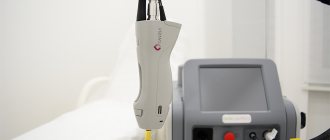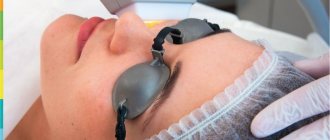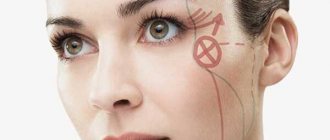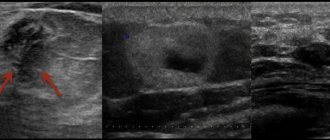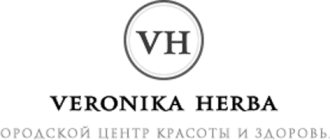- Laser resurfacing
- Non-ablative resurfacing
- Prices for laser resurfacing
Laser skin resurfacing is a deep peeling, during which, under the influence of a laser, the surface layer of the skin evaporates, which promotes increased production of collagen and elastin.
The skin in the correction area becomes an area of controlled burn, so after the procedure the dermis behaves accordingly and requires special care during the rehabilitation period. The duration of recovery depends on the type of device used, the adjustable power and depth of beam penetration, as well as on the individual characteristics of the skin.
ResurFX non-ablative resurfacing to rejuvenate and improve skin quality.
Laser face resurfacing!
Laser resurfacing. Treatment of post-acne scars!
Types of laser resurfacing devices
There are several main types of laser resurfacing, each of which has a special laser model. The choice of laser installation is made in accordance with the problem to be solved and the skin type. The names of lasers determine the type of active medium in which the beam is generated:
- Carbon dioxide CO2 devices - radiation is formed in carbon dioxide with a high concentration, has a long light wavelength, which allows the device to affect the depth of the skin, inaccessible with other types of radiation. Not suitable for correcting areas with delicate and thin skin; it is used to remove old cells, eliminate stretch marks, deep wrinkles, scars, tumors and spots, and provides a noticeable lifting effect. The rehabilitation period averages 2 – 4 weeks, during which time traces of the intervention disappear. Complete skin regeneration takes up to six months.
- Erbium devices - devices generate several microbeams that heat tissue in the desired location, without capturing nearby surfaces, the wavelength is limited - the effect is on the upper layers of the epidermis. The device is suitable for polishing sensitive skin of the eyelids and neck, eliminates medium-depth wrinkles, fights signs of pigmentation, evens out skin tone and provides a lifting effect. The rehabilitation period takes about 1 week.
- Fractional devices - have a targeted surface effect, do not injure healthy tissues, as a rule, a series of procedures is required to achieve maximum effect. Radiation promotes the renewal of aging skin, triggers the production of collagen, but does not “evaporate” the keratinized dermal layer and is not able to correct serious age-related changes. Complete tissue restoration occurs in 4–10 days.
Depending on the depth of the beam, non-ablative, ablative and fractional laser rejuvenation is distinguished. The non-ablative method (more often referred to as erbium resurfacing) does not injure the skin surface, involves light heating (42° - 45°) or coagulation (45° - 60°) of tissue, and there is practically no rehabilitation. Ablative laser rejuvenation involves a continuous impact on the entire surface of the skin; as a rule, it means carbon dioxide resurfacing. During fractional rejuvenation, the laser beam is scattered into many microbeams; depending on the adjusted depth of the device’s impact, this type of intervention can be classified as either ablative or non-ablative.
Laser resurfacing with erbium
In our center we use an erbium laser for skin resurfacing (Multiline laser complex)
Erbium laser resurfacing is designed to remove superficial and medium-deep wrinkles on the face, arms, neck or chest. One of the advantages of erbium laser resurfacing is minimal burn of surrounding tissue. This type of laser causes minimal side effects such as swelling, bruising and redness, so recovery time is shorter than with CO2 laser resurfacing.
Laser resurfacing with erbium in our center is carried out on an outpatient basis, using local anesthesia (pain relief at the procedure site), in combination with oral sedatives. Wrinkles around the eyes, mouth or forehead can be treated individually, or the entire face can be treated with laser treatment. Partial facial laser resurfacing takes 30-45 minutes, while the full face treatment lasts 1-1/2 to 2 hours.
With superficial and medium laser peeling, the recovery period lasts approximately 7-10 days . With deep laser resurfacing - up to 3-4-6 months . During the recovery period there is no need to be in hospital if there are no prerequisites for this in the form of complications. After laser peeling you can get the following:
- Younger and firmer skin;
- Improved blood circulation and complexion;
- Reduction or complete removal of wrinkles;
- Tightened facial contour;
- Elimination of minor skin defects;
- Reducing the size and visibility of deep scars, stagnant spots, including post-acne marks.
The full results of deep laser peeling can be assessed after 4-6 months, but at the same time they can please you for several years.
General recommendations
So, depending on the individual characteristics of the body, the type of device used and the depth of penetration of the laser beam, the rehabilitation period can take from 1 week to 1 month. During this period, for faster restoration of the skin, it is necessary to follow a number of recommendations common to all types of laser resurfacing:
- you should not wash your face for the first few days after the procedure;
- during the rehabilitation period, you should not use peelings, scrubs and aggressive cleansers;
- refuse decorative cosmetics until major peeling passes and the crusts fall off;
- apply light texture products and moisturizers to healed skin;
- sleep on your back for the first 2 - 5 days;
- avoid temperature swings and direct sunlight, use sunscreen for a month after the procedure;
- refuse to visit the solarium, bathhouse and swimming pool;
- reduce physical activity.
How to prepare?
Before laser resurfacing, the patient should follow a number of rules in order to properly prepare the skin for the procedure.
You should not sunbathe or visit a solarium for two weeks before the procedure. The laser beam is quite powerful, which can lead to excessive destruction of melanin. In this case, the skin will become unnaturally light and will differ significantly in color from other areas of the skin.
Be sure to tell your esthetician about any medications you are taking, especially antibiotics, hormonal medications, and medications that alter blood clotting. All of them can change the photosensitivity of the skin, so the doctor should be aware of their use before deciding to undergo such a procedure.
Choose the right time for this procedure - this should be the season with the least solar activity. The most optimal time for laser resurfacing is the period from October to the end of March.
Pay attention to the individual characteristics of your body. For example, patients who experience rashes on the face before menstruation should undergo laser resurfacing after menstruation so that the skin has time to return to normal.
Stages of healing
Recovery after laser resurfacing can be divided into main stages. At the first stage, the primary process of regeneration of damaged skin begins. There is slight swelling, redness, crusts and peeling. During this period, it is especially important to follow the recommendations described above.
At the second stage , the skin returns to normal; the main rule is not to forget about protection from UV radiation and moisturizing. You can gradually return to wearing light makeup and normal skin care without using aggressive products.
With the onset of the third stage, there is no need for special care shown in the first 2 stages. To speed up the rehabilitation process, you can resort to restorative injection procedures, such as mesotherapy or biorevitalization.
Price
The price of laser facial resurfacing depends on the rating of the clinic, equipment, doctor’s qualifications and city. The cost of the procedure in Yuzhnouralsk and Tula differs from the Moscow price list.
Resurfacing the eyelids costs from 5 thousand rubles, the neck - from 4 thousand rubles, the entire face - 2 times more expensive. Removing stretch marks on the hips will cost from 9 thousand rubles, on the buttocks and chest - 10 thousand rubles.
The cost of scar treatment depends on the area. Grinding 1 cm2 costs from 500 rubles. In Moscow, prices are at least twice as high.
Anesthesia and regenerative care after the procedure are additionally paid for.
How to care for a wound after cauterization
After laser removal, the scab is dense and dry; it tightly covers the damaged tissue from bacteria and other substances. Often, dermatologists simply ask not to touch the cauterization area, and not to treat it with anything. Wear natural fabrics to allow air to flow freely to this area, as the healing process in the open air is much faster. Also, for the first week, do not wet the area too much so that the sore does not get wet.
If the damage is localized in hard-to-reach and ventilated areas, it is additionally recommended:
- To reduce pressure on the cauterized area on the foot, wear loose shoes and use special orthopedic gel protectors;
- After removal, treat the mucous membranes with antiseptics (chlorhexidine, miramistin) 2 times a day;
- If the wound gets wet, it is dried with flucarcin for the first three days.
Advantages of the procedure
Laser resurfacing is popular and can quickly give you smooth, firm skin. At the first appointment, the cosmetologist will choose the type of laser and determine the depth of treatment of the epidermis.
Among the advantages of the procedure are the following:
- Slowing down aging. The laser beam removes the epidermis layer, this stimulates regeneration and collagen production. The effect of the procedure is especially noticeable after treating the skin around the eyes, as well as in the area of the chin and nasolabial folds.
- Relief leveling. The laser removes scars, pimples and congestive spots from rashes. If deep scars can be reduced in several procedures, then acne will disappear after one. Expression wrinkles disappear immediately and deep folds are reduced.
- Narrowing of pores. As a result of the activation of processes within the dermis, its renewal occurs. New areas with narrow and clean pores are formed.
- Improved complexion. When the recovery process is completed, patients will see that the skin has become lighter, age spots and freckles have disappeared.
Having decided to have laser resurfacing, you need to choose a clinic and a cosmetologist. The result will depend on the type of laser and the professionalism of the doctor. You need to contact medical centers that are known for high quality services.
The cosmetologist will examine the skin and propose a program to eliminate defects.
Skin care before and after laser hair removal, as well as during procedures
Although laser hair removal is a gentle and safe method of hair removal, after it the skin should receive the necessary care:
- For 6 weeks before and after, it is important to avoid sunbathing and tanning in a solarium.
- Preparation for laser hair removal also includes avoiding taking medications that have a reflective effect and blood thinning medications.
- For 6 weeks before the procedure, you cannot resort to other types of hair removal: sugaring, waxing, use an epilator or tweezers, as they remove hair from the root. Otherwise, the laser will not be able to recognize the hair follicle.
- For three days after epilation, massage and rubbing should not be done in the area where hair was removed. You should also avoid taking hot baths and visiting the sauna. This slows down recovery, and high temperatures have a negative effect on irritated skin.
- 3 days before hair removal, you should not use cosmetics that contain irritants, such as alcohol.
- During the period of laser hair removal, you cannot visit a solarium or use self-tanning cosmetics.
So, the procedure should be approached more responsibly by both cosmetologists and patients. And then laser hair removal, the consequences of which will be insignificant, will delight you with its high efficiency and will make you want to leave only the best reviews.
Nowadays, you no longer have to spend a lot of time performing complex and unpleasant procedures at home. It is much easier to seek help from real professionals - the Veronika Herba beauty and health center, equipped with effective and modern equipment.
Why clients choose Veronika Herba Beauty and Health Center:
- This is a beauty center where you can get laser hair removal at a reasonable cost, and you will be treated not by an ordinary cosmetologist, but by one of the best specialists in Moscow. This is a completely different, higher level of service!
- You can receive qualified help at any time convenient for you. The beauty center is open from 9:00 to 21:00, seven days a week. The main thing is to agree with your doctor in advance on the date and time of your appointment.
Sign up for a consultation with a specialist by phone +7 (495) 085-15-13, and you will see for yourself!
Price for services
| LASER COMPLEX MULTILINE, ERB | |||
| № | Name | Duration | price, rub. |
| 1 | Full face | 60-90 min | 15000 |
| 2 | Forehead | 30 min | 5000 |
| 3 | Cheeks | 30 min | 5000 |
| 4 | Chin | 30 min | 5000 |
| 5 | Upper lip | 30 min | 5000 |
| 6 | Laser blepharoplasty (upper and lower eyelids) | 30 min | 8000 |
| 7 | Neck | 30 min | 5000 |
| 8 | Face + neck | 60 min | 17000 |
| 9 | Cleavage | 30 min | 7000 |
| 10 | Face + neck + décolleté | 60 min | 20000 |
| 11 | Hands | 30 min | 5000 |
| 12 | 1 sq. cm | 10 min | 500 |
Myths about the health consequences of laser hair removal
Some stereotypes regarding laser hair removal have arisen due to the fact that in the past the equipment used had a number of disadvantages. As devices are modernized, they become safer, which expands their capabilities and reduces the risk of negative consequences.
Myth 1: Laser work can cause cancer
The consequence of laser hair removal is cancer. This is the most popular myth. From the point of view of the risk of developing cancer, the most dangerous is high-frequency ionizing radiation - X-rays and gamma rays. Laser radiation used in hair removal procedures is non-ionizing.
Myth 2: After the procedure, scars will remain and hair will begin to grow in
Scarring occurs during electrolysis, when needles are used that damage the surface of the skin and are inserted into the upper layer of the dermis.
Laser hair removal does not violate the integrity of the skin, so scarring is simply impossible.
And ingrown hairs are a consequence of unprofessional waxing. When a thinning hair does not have the strength to break through the skin, it simply grows under it. The laser is precisely aimed at eliminating such manifestations.
Myth 3: After the procedure, a large amount of coarse hair will appear.
After each treatment, the hair grows back finer, there is less of it and it appears more and more slowly. The paradoxical effect can be observed only once - after the second session. This is called synchronization and indicates the effectiveness of the procedure. In the third session, all this vegetation is removed, and after that the hair grows slowly, becoming softer.
Myth 4: Laser hair removal is a rather painful procedure
The cause of pain during procedures is the effect on the nerve fibers that are located in the skin. Each person has these fibers configured differently, so we all experience pain differently. Cosmetologists note that the sensations during the procedure are comparable to a click on the skin and are usually tolerated normally. In addition, at the client’s request, the cosmetologist, of course, can apply an anesthetic cream.
Myth 5: Laser hair removal cannot be done in the summer
The time of year cannot be an obstacle to removing excess hair on the body. Moreover, this is especially important in the summer. In fact, procedures can be planned during the holiday season, the main thing is to know some of the nuances.
If you need to treat areas hidden under clothing, for example, the bikini area, there are no problems here. The procedure can be performed at any time. Laser hair removal should not be performed on tanned or dark skin. This will cause burns.
We recommend
Laser hair removal of the upper lip: effective and reliable or expensive and useless?
Read more And one more myth – rather one of the false positives. No additional care is needed after the procedure. This is wrong. The skin has experienced serious stress during laser hair removal and needs additional protection.
How does laser affect tissue?
Let's figure out how a CO2 laser affects tissue when it cauterizes tumors. The doctor directs the laser beam at the area of removal; when the beam hits the tissue, it is reflected and causes pendulum-like movements of the molecules, which leads to the evaporation of water from the cell and charring of the tissue. Part of the energy is transferred to surrounding cells, in which, under the influence of high temperatures, reversible protein denaturation occurs. It is the latter effect that causes the appearance of redness and swelling around the cauterization site.
But I would like to note that the surface after laser removal has a number of differences from other types of wounds, for example after a scalpel or electrocoagulation:
- The incision is made without touching the surface of the skin, this 100% guarantees the risk of infection;
- The laser coagulates the superficial layers of the dermis, while the deep ones remain undamaged, which is why it does not cause scarring and stenosis;
- Another feature is that after laser exposure in tissues, the temperature rises, this leads to the death of bacteria and viruses, thus it has an antiseptic effect;
- In the area affected by the laser, due to high temperatures, the vessels are sealed, so there is no bleeding, and a dense scab is formed that closes the wound, preventing bacteria from entering it;
- After laser exposure, regenerative processes at the site of exposure are stimulated due to the penetration of a small amount of light quanta into the deep structures of the skin;
- Compared to other types of cauterization, with laser cauterization the swelling around the wound is less pronounced and therefore there is no pain after laser removal.
Thanks to the above symptoms, the wound heals faster after laser, almost never suppurates or causes pain, and most importantly, does not lead to the formation of scars.


